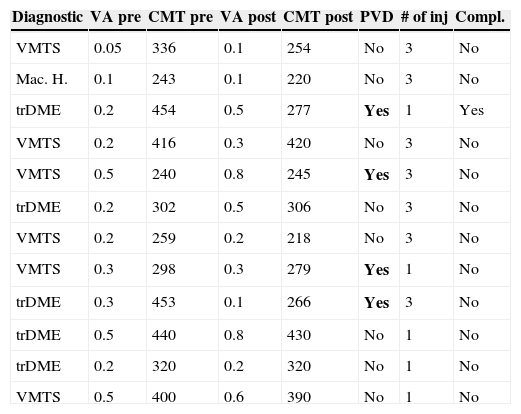To determine whether intravitreal injection of autologous plasmin enzyme (APE) is effective in vitreomacular traction syndrome (VMTS) by improving visual acuity and restoring macular morphology.
MethodsA prospective study of 11 consecutive patients diagnosed with VMTS in the Ophthalmology Department from January to May 2011. Inclusion criteria: best corrected visual acuity (BCVA) less than 0.5, and vitreomacular attachment in foveal area resulting in macular thickness >250μm diagnosed by optical coherence tomography (Cirrus OCT, Carl Zeiss Meditec, Inc, Oberkochen, Germany). Exclusion criteria: active proliferative diabetic retinopathy, axial myopia >26mm, vitrectomy, glaucoma, previous intravitreal injections and previous rhegmatogenous detachment. One to the 3 monthly intravitreal injections of 0.2ml of APE was applied, interrupting if posterior vitreous detachment was attained. Wilcoxon's test was used for statistical analysis.
ResultsA total of 12 eyes of 11 patients were treated. A complete posterior vitreous detachment was achieved in 4 (33%) eyes at the end of the study, 2 of them with one injection, and 2 with 3 monthly injections. Improvement of BCVA was statistically significant (p=0.017) and the decrease in central macular thickness also was statistically significant (p=0.016). There was only one complication: intraocular hypertension after injection that subsided with a new paracentesis.
ConclusionsIntravitreal APE injections avoided vitrectomy in VMTS in one in every 3 patients.
Analizar si la inyección intravítrea de plasmina autógena es eficaz en el síndrome de tracción vítreo-macular (STVM), mejorando la agudeza visual y restaurando la morfología macular.
MétodosEstudio prospectivo de 11 pacientes consecutivos diagnosticados de STVM en nuestro Servicio de Oftalmología de enero a mayo de 2011. Criterios de inclusión: mejor agudeza visual corregida (MAVC) inferior a 0,5 y adhesión vítreo-macular foveal, ocasionando aumento del grosor macular central (GMC) > 250μ diagnosticado mediante tomografía de coherencia óptica (Cirrus OCT, Carl Zeiss Meditec, Inc, Oberkochen, Alemania). Criterios de exclusión: retinopatía diabética proliferante activa, miopía axial > 26mm, vitrectomía previa, glaucoma, intravítreas previas y antecedentes de desprendimiento de retina. Se realizaron hasta 3 inyecciones mensuales de 0,2ml de plasmina autógena, evaluándose a las 3 semanas de cada inyección el despegamiento de la adhesión vítreo-macular (AVM), MAVC, GMC y la recuperación de morfología macular en la OCT, interrumpiendo el tratamiento en caso de éxito. Análisis estadístico con test de Wilcoxon.
ResultadosDe 12 ojos de 11 pacientes se consiguió despegamiento de AVM en 4 (33%), 2 con una inyección y 2 con 3 inyecciones. La mejoría de la MAVC (p=0,017) y la disminución del GMC (p=0,016) fueron estadísticamente significativas, mejorando la morfología macular en todos los casos con despegamiento de la AVM. La única complicación fue un caso de hipertensión intraocular tras la inyección, que cedió repitiendo la paracentesis.
ConclusionesLa inyección de plasmina autógena evitó la vitrectomía del STVM en uno de cada 3 pacientes.










